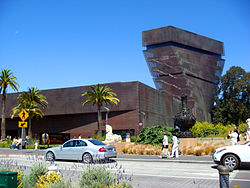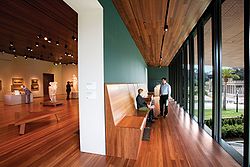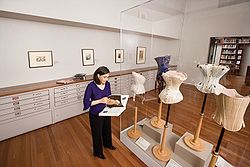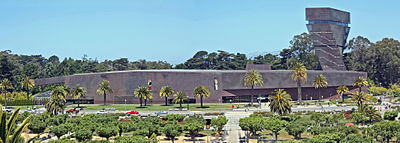- M. H. de Young Memorial Museum
-
M. H. de Young Memorial Museum 
Established March 24, 1895 Location 50 Hagiwara Tea Garden Drive, San Francisco, California, USA Type Art museum Visitor figures 2,043,854 (2010)[1]
- Ranked 4th nationally
- Ranked 16th globally
Director John E. Buchanan, Jr. Public transit access 44 O'Shaughnessy, San Francisco Municipal Railway Website http://www.famsf.org/deyoung/ The M. H. de Young Memorial Museum, commonly called simply the de Young Museum, is a fine arts museum located in San Francisco's Golden Gate Park. It is named for early San Francisco newspaperman M. H. de Young.
Contents
History
The museum opened in 1895 as an outgrowth of the California Midwinter International Exposition of 1894 (a fair modeled on the Chicago World's Columbian Exposition of the previous year). It was housed in an Egyptian style structure which had been the Fine Arts Building at the fair. The building was badly damaged in the earthquake of 1906 and was demolished and replaced in 1929 with a Spanish Renaissance style structure. This building was originally decorated with cast-concrete ornaments on the façade. The ornaments were removed in 1949 as they began to fall and had become a hazard.[citation needed] As part of the agreement that created the Fine Arts Museums of San Francisco in 1972, the de Young's collection of European art was sent to the Legion of Honor. In compensation, the de Young received the right to display the bulk of the organization's anthropological holdings. These include significant pre-Hispanic works from Teotihuacan and Peru, as well as indigenous tribal art from sub-Saharan Africa. The building was severely damaged by the 1989 Loma Prieta earthquake.[2] It in turn was demolished and replaced by a new building in 2005.
Collections
The de Young Museum showcases American art from the 17th through the 21st centuries, international contemporary art, textiles, and costumes, and art from the Americas, the Pacific and Africa.
American
The American art collection consists of over 1,000 paintings,[3] 800 sculptures, and 3,000 decorative arts objects.[4] With works ranging from 1670 to the present day, this collection represents the most comprehensive museum survey of American art in the American West and is among the top ten collections nationally that encompass the entire history of non-indigenous American art. Since its inception in the Fine Arts Building at the California Midwinter International Exposition of 1894 in Golden Gate Park, its subsequent institutionalization in the M. H. de Young Memorial Museum in 1924, and its reinstallation in the new de Young in 2005, the permanent collection has evolved exponentially.
In 1978, the American art collections were transformed by the decision of John D. Rockefeller III and Blanchette Hooker Rockefeller to donate their renowned collection of 110 paintings, 29 drawings, and 2 sculptures to the Fine Arts Museums of San Francisco where they would be on view at the de Young Museum. His bequest in 1979 together with her bequest in 1993 are among the Fine Arts Museums’ single most important gifts of art.
The de Young’s chronological survey of American art includes galleries devoted to art in the following areas: Native American and Spanish Colonial; Anglo-Colonial; Federal and Neoclassical; Victorian genre and realism; trompe l’oeil still life; the Hudson River School, Barbizon, and Tonalism; Impressionism and the Ashcan School; Arts and Crafts; Modernism; Social Realism and American Scene; Surrealism and Abstraction; Beat, Pop, and Figurative; and contemporary.
Although the permanent collection is national in scope, art made in California from the Gold Rush era to the present day is also on display in the de Young Museum. Important California collections with national significance include examples of Spanish colonial, Arts and Crafts, and Bay Area Figurative and Assemblage art. Important among them are the most significant museum collections of works by Bay Area painter Chiura Obata and sculptor Ruth Asawa.
The permanent collection galleries integrate decorative arts objects with paintings and sculptures, emphasizing the artistic, social, and political context for the works on display. While essentially chronological, the installation also juxtaposes works from different cultures and time periods to emphasize the historical connections between works in the collection.Painters with paintings in this art museum include; John Copley, John Vanderlyn, Thomas Cole ("Promethous Bound", Thomas Hill, Thomas Wood ("Newspaper Vendor"), Samuel Brookes, John Peto, Childe Hassam, George Hitchcock, Maynard Dixon, Otis Oldfield, Granville Redmond, Thomas Hart Benton ("Sauannah and The Elders"), David Park, Richard Diebenkorn, Mel Ramos, and Wayne Thiebaud.
- Archives of American Art
Since 1991, the American Art Department has housed a set of the Smithsonian Institution’s Archives of American Art microfilm collection. In conjunction with the Bothin Library and department research files, the American Art Study Center is the most important research center for American art on the West Coast.
International contemporary
In 1988, the Fine Arts Museums made a commitment to collect international contemporary art. In addition to works in traditional media, this commitment has expanded the Museums’ holdings of works in new or multiple media––including installation and conceptual works, video and other time-based media, and photography and other lens-based media––to more accurately reflect contemporary art practice.
Recent contemporary acquisitions include Wall of Light Horizon (2005), by Sean Scully and signature sculptures by Zhan Wang and Cornelia Parker. The strength of the collection lies in artists associated with California, including Piotr Abraszewski, Christopher Brown, Squeak Carnwath, Jim Christiansen, Robert Colescott, Hung Liu, Bruce Nauman, Rachel Neubauer, Ed Ruscha, and Masami Teraoka.
Lens-based and time-based media represent a new area of growth, with works by Nigel Poor, Catherine Wagner, Rebeca Bollinger, and Alan Rath. The Museums have also acquired works by international artists such as Anish Kapoor, Odd Nerdrum, Gottfried Helnwein, Doris Salcedo, David Nash, Barbara Hepworth, and Richard Deacon.
Textiles and costumes
The Fine Arts Museums’ textiles collection[5] boasts more than 12,000 textiles and costumes from around the world. It is one of the largest and most comprehensive collections of its type in the United States. It comprises costume and costume accessories; loom-woven textiles; non-woven fabrics such as bark cloth, felt, and knitting; and objects whose primary decoration is produced through techniques such as beading and embroidery. With holdings that span two and a half millennia and represent cultures from 125 countries, the textile arts collection enables the Museums to draw connections across cultures and enrich its other collections.
Highlights from the collection include extraordinary Turkmen carpets, rare 12th through 15th-century Central Asian and North Indian silks, the most important group of Anatolian kilims outside Turkey, European tapestries, and contemporary fiber art.
The de Young Museum has exhibited fashion since the 1930s and is known for its 20th-century couture, particularly from the post–World War II era, with pieces by Dior, Balenciaga, Madame Grès, Yves Saint Laurent, Chanel, Ralph Rucci, and Kaisik Wong. There are equally compelling collections of 18th and 19th-century European fans, an excellent lace collection, a spectacular group of European ecclesiastical vestments and furnishings, and a growing collection of contemporary wearable art.
Africa, Pacific, and the Americas
More than 1,400 stellar examples from the eastern Sudan, the Guinea coast, west and central Africa, eastern and southern Africa, and elsewhere on the continent are included in the Fine Arts Museums’ African art collection[6] at the de Young Museum. The African art collection is presented thematically rather than geographically, emphasizing the aesthetic and expressive qualities of the art.
The Oceanic collections[7] were charter collections of the de Young, their nucleus formed in 1894 at the California Midwinter International Exposition in Golden Gate Park. Additional Oceanic works of sculpture, basketry, tapa, ceramics, and lithics have since been acquired, bringing the holdings to more than 3,000. Highlights of the collection include a 10-foot (3.0 m) housepost from the Iatmul culture of Papua New Guinea, a group of brightly painted carvings used in malanggan ceremonials of New Ireland, a roll of feather money from Nindu Island of Santa Cruz, a fan from the Marquesas Islands of Polynesia, a rare navigation figure from the Caroline Islands of Micronesia, and a selection of powerful wood carvings from the Maori peoples of New Zealand.
The Art of the Americas collections[8] are of national significance to art history, anthropology, and world history, and they have helped establish the de Young as a primary source for cultural research and study. The extensive collection of ancient American and Native American art comprises nearly 2,000 works of art from Meso-America, Central and South America, and the West Coast of North America. Art from cultures indigenous to the American continents was a defining feature of the Museum’s charter collection and continues to be an area of significant growth. Special galleries are devoted to ancient objects from Mexico, including an outstanding grouping of Teotihuacan murals.
Architecture
The current building was completed by architects Jacques Herzog, Pierre de Meuron and Fong + Chan designed the newly built structure, which reopened on October 15, 2005. Structural, civil and geotechnical engineering was provided by Rutherford & Chekene; Arup provided mechanical and electrical engineering. The terrain and seismic activity in San Francisco posed a challenge for the designers Herzog & de Meuron and principal architects Fong & Chan. To help withstand future earthquakes, “[the building] can move up to three feet (91 centimeters) due to a system of ball-bearing sliding plates and viscous fluid dampers that absorb kinetic energy and convert it to heat”.[9]
A new museum structure located in the middle of an urban park was initially controversial. San Francisco voters twice defeated bond measures that were to fund the new museum project. After the second defeat, the museum itself planned to relocate to a location in the financial district. However, an effort led by generous supporters arose and kept the museum in the Golden Gate Park.
The designers were sensitive to the appearance of the building in its natural setting. Walter Hood, a landscape architect based in Oakland, designed the museum's new gardens. The entire exterior is clad in 163,118 sq ft (15,154.2 m2) of copper, which is expected to eventually oxidize and take on a greenish tone and a distinct texture to echo the nearby eucalyptus trees. In order to further harmonize with the surroundings, shapes were cut into the top to reveal gardens and courtyards where 48 trees had been planted. 5.12 acres (20,700 square meters) of new landscaping were planted as well, with 344 transplanted trees and 69 historic boulders. The building is clad with variably perforated and dimpled copper plates, whose patina will slowly change through exposure to the elements. This exterior facade was developed and fabricated by engineers at Zahner.[10] A 144 ft. (44 m) observation tower allows visitors to see much of Golden Gate Park's Music Concourse (see below) and rises above the Park's treetops providing a view of the Golden Gate and Marin Headlands.
The twisting 144 foot (44 m) tall tower is a distinctive feature, and can be seen rising above the canopy of Golden Gate Park from many areas of San Francisco. The museum offers a two-floor museum store, free access to the lobby and tower, and a full-service cafe with outdoor seating in the Osher Sculpture Garden. The executive chef is Lance Holton.
Notes
- ^ "Exhibition and museum attendance figures 2010". London: The Art Newspaper. April 2011. http://www.theartnewspaper.com/attfig/attfig10.pdf. Retrieved 11 April 2011.
- ^ Amy Weaver Dorning "Museum Renovation: A Great Institution Gets Greater," American Heritage, Nov./Dec. 2006.
- ^ FAMSF.org.org
- ^ FAMSF.org
- ^ FAMSF.org
- ^ FAMSF.org
- ^ FAMSF.org
- ^ FAMSF.org
- ^ Ashmore
- ^ Peter Hall. "Sheet Metal Magicians". Metropolis Magazine. http://www.metropolismag.com/story/20050919/sheet-metal-magicians. Retrieved 2010-04-29.
References
- Ashmore, Lisa. “San Francisco's New de Young.” Architecture Week
- Guthrie, Julian. “De Young's Rebirth.” San Francisco Chronicle, 15 October 2005.
- King, John. “Into The Modern Age.” San Francisco Chronicle, 9 October 2005.
- Sardar, Zahid. “Painting A New Landscape.” San Francisco Chronicle, 9 October 2005, retrieved 22 September 2006.
External links
Museums Asian Art Museum · Berkeley Art Museum and Pacific Film Archive · Cantor Center for Visual Arts · Cartoon Art Museum · Palace of the Legion of Honor · Contemporary Jewish Museum · de Young Museum · Mexican Museum · Mills College Art Museum · Museo ItaloAmericano · Museum of Craft and Folk Art · Museum of the African Diaspora · Oakland Museum · Randall Museum · San Jose Museum of Art · SFMOMA · Wattis Institute for Contemporary Arts · Yerba Buena Center for the Arts
Artist-in-residence programs Public and site-specific Defunct Coordinates: 37°46′17″N 122°28′07″W / 37.771389°N 122.468611°W
Categories:- Museums in San Francisco, California
- Art museums in California
- Institutions accredited by the American Association of Museums
- Golden Gate Park
- Buildings and structures completed in 1895
- Buildings and structures completed in 2005
- Museums established in 1895
- Herzog & de Meuron buildings
- Ove Arup buildings and structures
- Deconstructivism
- Twisted buildings and structures
- Postmodern architecture in California
- World's fair architecture in the United States
Wikimedia Foundation. 2010.



